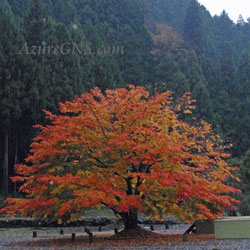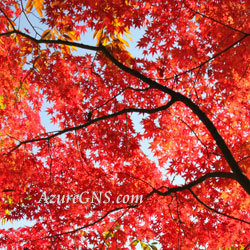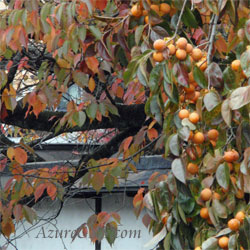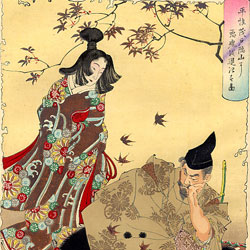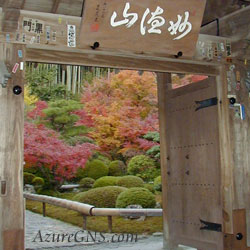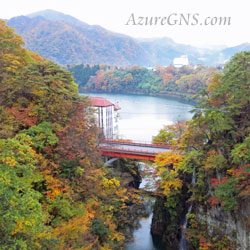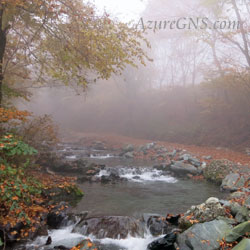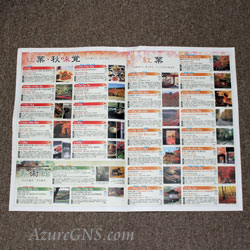(10月-11月)
Momiji-gari;
The Season of Autumn Leaves Viewing;
(From October to November)
●紅葉狩り Momiji-gari; autumn foliage viewing; the fall foliage viewing; autumn leaves viewing; leaf peeping
●紅葉狩りに行く (to) go Momiji-gari; (to) view autumn foliage; (to) view the autumn leaves; (to) enjoy the autumn leaves
●紅葉(こうよう) red (and yellow) leaves; autumn leaves; tinted autumnal leaves
●紅葉する (to) turn red; (to) turn yellow; (to) turn red and yellow
●紅葉(もみじ) Japanese maple
●銀杏(いちょう) ginkgo
●自然 nature
●日本庭園 Japanese garden
●神社仏閣 Shinto shrines and Buddhist temples
●ライトアップする (to) illuminate (ライトアップは和製英語)
●気象庁 the Meteorological Agency
●気温 temperature
●日照時間 amount of sunlight
◆日本では秋の深まりとともに樹木が鮮やかに紅葉し、その美しさに心打たれます。
People are deeply impressed with leaves of trees vividly turning red and yellow as autumn advances in Japan.
◆そして散りゆく木の葉のはかない美しさは哀愁を帯びています。
The fragility of the beauty of falling leaves has a touch of melancholy.
◆平安時代(794-1185)の貴族が紅葉を愛でながら宴を開き、紅葉を題材に競って和歌を詠んだと言われています。
It is said that aristocrats in the Heian period (794-1185) held a banquet to enjoy the autumn leaves and competed with each other in making Waka (a Japanese traditional poetry with 5-7-5-7-7 syllable) on the theme of autumn leaves.
◆紅葉狩りを直訳すると「紅葉を狩る」になります。
Momiji-gari literally means “maple hunting”.
◆「狩り」は元来、獣を捕まえるという意味だけに使われましたが、鳥や小動物を捕ることも指すようになりました。
Originally, “gari” and “kari” were used only for animal hunting but later came to be also used for bird hunting and small animal hunting.
◆そして今では、苺、柿、りんご、梨、葡萄、筍、茸などを採る時にも狩るという言葉を使います。
Now we even use “gari” and “kari” for picking strawberries, persimmons, apples, pears, grapes, bamboo shoots and mushrooms.
◆しかし紅葉狩りは観賞するだけで、枝を折って取ることはありません。
However, as for Momiji-gari, we only enjoy viewing autumn leaves and never break the branches from trees.
◆平安時代には実際に木の枝を折り、手に取ったこともあったようですが、自然をいつくしむという考えからその慣習はなくなりました。
In the Heian period, people often removed branches from the trees, but gradually they gave up the custom to show appreciation for nature.
◆紅葉は「紅色の葉」という意味ですが、広義では黄色や褐色になるものも含まれます。
Koyo means “red leaves” but yellow leaves and brown ones are also included in the broader sense.
◆赤く色づく代表的なものはモミジ、ウルシ、ハナミズキで、黄色はイチョウ、ポプラ、ニレで、褐色はブナ、カシワ、ケヤキです。
Representative red leaves are maples, sumacs and dogwoods; and yellow leaves are ginkgoes, poplars and elms, and brown leaves are beeches, oaks and zelkovas.
◆多くの日本庭園、神社仏閣、街路にこのような木が植えられています。
These deciduous trees are planted in Japanese gardens, Shinto shrines, Buddhist temples and on the streets.
◆日本では古くから、紅葉は和歌、俳句、小説、絵画など様々な芸術の題材になります。
Autumn leaves have long been the themes of various arts such as Waka, Haiku (a Japanese traditional poetry with 5-7-5 syllable), novels and pictures.
◆能の演目の「紅葉狩り」は、戸隠村の鬼女伝説を元に約500年前に作られ、現行演目の一つです。
A program of a Noh play called “Momiji-gari” was created about 500 years ago based on the legend of Kijyo (an ogress) in Togakushi Village, and this is one of the presently performed programs.
◆唱歌「もみじ」の美しい歌詩とメロディーは明治時代(1868-1912)より多くの日本人に愛されています。
The beautiful lyrics and melody of the song titled “Momiji” (Japanese maples) has been loved by many Japanese since the Meiji era (1868-1912).
◆紅葉は京都、箱根、日光などの紅葉の名所はもちろん、日本中で楽しまれています。
We enjoy viewing autumn leaves throughout Japan, including of course famous places such as Kyoto, Hakone and Nikko.
◆紅葉は樹木により葉が色づく時期が異なるため、長い間さまざまな色合いを楽しむことができます。
We enjoy various patterns of autumn leaves for a long period because the timing when leaves change their colors vary depending on the trees.
◆紅葉の時期は行楽に適している気候でもあり、各地の紅葉の名所は、多くの観光客が訪れ大変混雑します。
The famous places for their beautiful autumn leaves are very crowded with many tourists because this time of year is also a suitable climate for excursions.
◆お花見の時期の桜同様、地方自治体が紅葉を、夜間にライトアップすることがよくあります。
Local governments often illuminate the autumn leaves at night similar to cherry blossoms during the cherry blossom viewing season.
◆落葉して地面を彩る美しい様子も味わいがあります。
Colorful beautiful fallen leaves on the ground are also very impressive.
◆日本は南北に細長い国なので、桜前線同様に、紅葉前線の時期も北海道と九州ではかなり異なっています。
As Japan is elongated from north to south, the autumn leaves front varies greatly from Hokkaido to Kyushu like the cherry blossom front.
◆たとえば、北海道では9月には紅葉が始まりますが、九州では11月の末から12月の初めごろ始まるという遅さです。
For example, in Hokkaido, leaves begin to turn red and yellow in mid-September while in Kyushu, as late as the end of November or the beginning of December.
◆地球温暖化のために紅葉の時期は徐々に遅くなり、またその美しさにも悪い影響を与えています。
Global warming has caused the gradual delay of the autumn leaf season and has a negative influence upon their beauty.
◆新聞やウェブサイトで、紅葉の名所の予想見頃時期や状況を見ることができます。
Newspapers and websites publish autumn leaf schedules in advance and the current status of famous places.
◆天候や日照量など様々な条件で、紅葉の美しさはその年によって変わります。
The beauty of autumn leaves is different from year to year due to varying conditions such as weather patterns and the amount of sunlight.
◆昼夜の大きな温度差や、日差しが強く暑い夏の後秋になり急激に温度が下がると、美しい紅葉になると一般に言われています。
Generally speaking, the extreme difference of temperature by day and night and a sharp drop of temperature in autumn after summer with strong sunlight and severe heat are essential for beautiful autumn foliage.
(より詳しい情報は「我が家の紅葉狩り」を覧下さい。)
(Please see “Our Autumn Leaves Viewing Experience” for further information.)
Copyright (C) Azure Global Network Services. All Rights Reserved.
